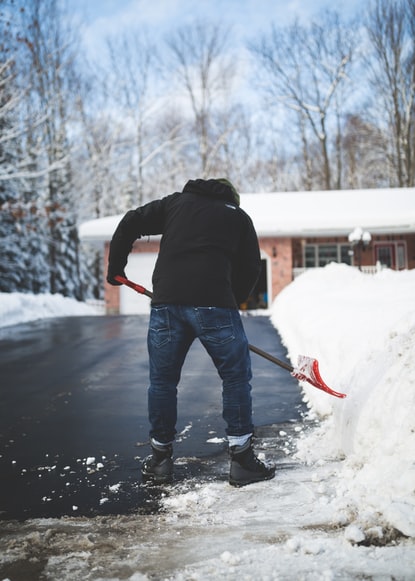10 Snow Shoveling Safety Tips
How important is snow shoveling safety in Central Indiana? Since 2010, Indianapolis has averaged more than 25 inches of snow per year, Snowfall totals Indianapolis. That’s a significant amount of snow to shovel from drives and walkways. It might not be as much as Buffalo, New York, a city that averages 90 inches of snow a year, but it does add up.
The snow begins falling as early as November and continues through March. (Does it snow every year during high school basketball sectionals?)
For those hoping for a white Christmas, Indy averages 6 inches of snow in December. However, the last Christmas Indy had any snow on the ground was 2017. On Christmas Day, 2017, 0.1 inches fell. In 2004 we had 9 inches on Christmas day!
10 Snow Shoveling Safety Tips
Every winter, there are thousands of injuries and more than 100 deaths associated with snow removal. Many, if not most, of these injuries and deaths, could’ve been avoided by following these basic snow shoveling safety tips.
1. Warm-up
Before you head outside, do a few bends, lifts, and stretches to get your motor running.
2. Layer upon layer
Wear multiple layers of clothing. Insulated or thermal undergarments are a good place to start. Be sure to include waterproof gloves (I wear ski gloves) and a warm hat that covers your ears. I learned last year that wearing a mask really makes a difference in the cold.
3. Don’t wait too long
It’s better to shovel snow early and often rather than wait for it to build up. The heavy snow is harder to move, and in Central Indiana, the sun can warm it up, make it sloshy, and then refreeze it, making it much more difficult to remove.
4. Speaking of ice
Reduce the impact of ice by spreading sand, salt, or kitty litter on your walks and drive.
5. Get a good shovel
Buy a quality shovel that fits you. Don’t get me wrong, I like dollar stores as much as the next person, but it’s not the place to buy a snow shovel. Be sure the shovel fits your height, strength, and even your hands.
6. Start slow
Rome wasn’t snow shoveled in a day. Don’t attack the snow with a vengeance. Go slow on the snow. Also, take a break every 20-30 minutes. Go inside, take off your hat and gloves, and warm-up.
7. Wait 30 minutes before you jump in
Wait at least 30 minutes after eating before shoveling snow. Give your body a chance to start digesting your meal before adding the stress of the cold and exercise.
8. Hydrate
Before heading out to the great outdoors, drink plenty of water or electrolyte drinks. And no, coffee does not count.
9. Use smart shoveling
Smart shoveling starts with push don’t lift. Whenever possible, push the snow off the drive or walk. Don’t lift and throw. If you must scoop the snow, be sure to use small shovelfuls. You might even want to consider a smaller shovel for scooping.
10. Keep your phone handy
Keep your phone in your pocket in case of an emergency. Sure, I know you’re young and healthy, but wouldn’t it be better to be safe than to be sorry?
Pro Tip: Know the signs of a heart attack
- Chest pain
- Shooting pain in arms, back, neck, or jaw.
- Shortness of breath
- Cold sweats
- Nausea
- Lightheadedness
You don’t need to experience all these symptoms for it to be a heart attack. Any one of these could be cause for concern.
Bonus Subhead: Snow Blower Safety
So, you finally got rid of the ole snow shovel and bought a snow blower. Good for you! However, every year people end up in the emergency room from snow blower accidents. Here are a few tips to help you stay safe.
- Read your manual. This isn’t an online app where you click, I agree without reading the information. This is a piece of equipment that, when misused, can lead to devastating results. Not only read your manual but review it yearly before the snow season.
- Never ever never put your hands or feet in a running blower. I know, it sounds silly even to say, but every year people lose fingers, toes, hands, and feet trying to punch or kick loose something stuck in their blower. Your gloves or boots will not protect you from the blades. If it jams, turn it off before attempting to remove debris.
- Do not pour fuel into a hot machine. Fill up your mower before you start it, and if you need to refill it, let it cool down. One of the reasons people end up in the emergency room is a snow blower fire or explosion.
- Never leave a running snow blower unattended. If you must walk away, turn it off.
How Can We Help You?
Berger Hargis has a company philosophy of providing personal excellence for all our services. Our growth and success have been due entirely to our commitment to honest, excellent customer service. The company has been built on the referral business we have received due to this philosophy.
If we can answer any questions, please don’t hesitate to Contact Us.
Photo by Filip Mroz on Unsplash
Go Back







